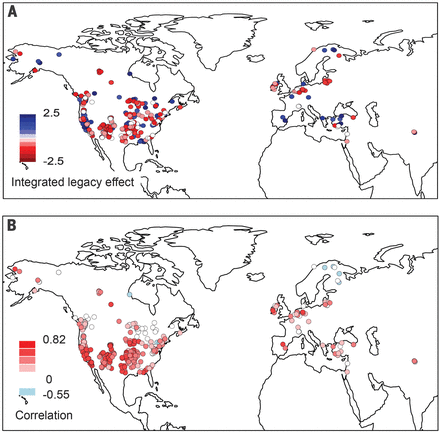


据一项新的研究报告:在遭遇严重干旱后,森林树木生长可放缓长达4年,在这一时期内,它们不太能够充当碳汇。这项研究的结果提示,目前的地球系统模型应该纳入干旱对森林的影响,这样才能更准确地预测干旱会如何改变全球的碳循环。研究人员提出,气候变化可导致更频繁及/或剧烈的极端气候,其中包括更严重的干旱。然而,人们对极端气候对森林的影响知之甚少,而这些影响对预测改变气候的碳循环变化是至关重要的。试图捕捉这些影响的模型常常假设植被在极端干旱后的恢复是快速和完全的,而有些科学家则对此存疑。William Anderegg和同事在此对世界各地1338处森林在严重干旱后树干生长的恢复进行了检查,并将他们所观察到的与来自不同气候-植被模型的树干生长的模拟结果进行了比较。在观察到的数据中,研究人员在许多生物类群及广泛地理范围内经常性地发现植被生长在严重干旱后会减缓1至4年,尤其是在干旱的生态系统中。与此相反,他们所研究的这些模型显示,干旱在同样这些区域中的影响是极小的,提示可能需要对这些工具进行重新评估,因为这样才能准确地捕捉到干旱的影响。 (来源:生物360)
Pervasive drought legacies in forest ecosystems and their implications for carbon cycle models
Abstract The impacts of climate extremes on terrestrial ecosystems are poorly understood but important for predicting carbon cycle feedbacks to climate change. Coupled climate–carbon cycle models typically assume that vegetation recovery from extreme drought is immediate and complete, which conflicts with the understanding of basic plant physiology. We examined the recovery of stem growth in trees after severe drought at 1338 forest sites across the globe, comprising 49,339 site-years, and compared the results with simulated recovery in climate-vegetation models. We found pervasive and substantial “legacy effects” of reduced growth and incomplete recovery for 1 to 4 years after severe drought. Legacy effects were most prevalent in dry ecosystems, among Pinaceae, and among species with low hydraulic safety margins. In contrast, limited or no legacy effects after drought were simulated by current climate-vegetation models. Our results highlight hysteresis in ecosystem-level carbon cycling and delayed recovery from climate extremes.
原文链接:http://www.sciencemag.org/content/349/6247/528.full.pdf



